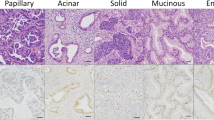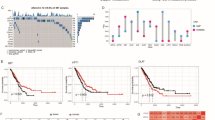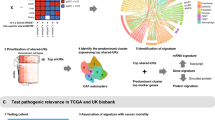Abstract
Purpose
Despite advances in the treatment of laryngeal squamous-cell carcinoma (LSCC), the survival rate of LSCC remains poor. Thereby, it is urgent to identify novel diagnostic and prognostic biomarkers for LSCC. The study aimed to identify potential core genes associated with the pathogenesis and prognosis of LSCC.
Methods
Differentially expressed genes between LSCC and normal laryngeal tissue samples were screened by an integrated analysis of data from GEO and TCGA databases. Core genes related to the pathogenesis and prognosis of LSCC were identified by employing protein–protein interaction network and Cox proportional hazards model analyses.
Results
Ten hub genes (AURKA, AURKB, CDC45, KIF2C, NDC80, EXO1, TYMS, RAD51AP1, ITGA3, and UBE2T) that might be highly related to the pathogenesis of LSCC were identified. An eight-gene prognostic signature consisted of ZG16B, STATH, RTN4R, MSRA, CBX8, SLC5A1, EFNB1 and CNTFR was constructed with a good performance in predicting overall survivals.
Conclusion
Our findings might shed some new light on the pathogenesis of LSCC and help identify new therapeutic targets of LSCC.





Similar content being viewed by others
Abbreviations
- LSCC:
-
Laryngeal squamous-cell carcinoma
- TCGA:
-
The Cancer Genome Atlas
- GEO:
-
Gene expression omnibus
- PPI:
-
The protein–protein interaction network
- GO:
-
Gene ontology
- DEG:
-
Differentially expressed gene
- OS:
-
Overall survival
References
Siegel RL, Miller KD, Jemal A (2016) Cancer Statistics, 2016. Ca Cancer J Clin 66(1):7–30. https://doi.org/10.3322/caac.21332
Steuer CE, El-Deiry M, Parks JR, Higgins KA, Saba NF (2017) An update on larynx cancer. Ca Cancer J Clin 67(1):32–50. https://doi.org/10.3322/caac.21386
Li DD, Feng JP, Wu TY, Wang YD, Sun YN, Ren JY, Liu M (2013) Long intergenic noncoding RNA HOTAIR is overexpressed and regulates PTEN methylation in laryngeal squamous cell carcinoma. Am J Pathol 182(1):64–70. https://doi.org/10.1016/j.ajpath.2012.08.042
Tang XB, Shen XH, Li L, Zhang YF, Chen GQ Auris Nasus Larynx 40(5):481–486. https://doi.org/10.1016/j.anl.2013.01.003
Ma ZH, Zhang H, Lian M, Yue CL, Dong GH, Jin YL, Li R, Wan HF, Wang R, Wang Y, Zhai J, Ma HZ, Feng L, Han JF, Liu SZ, Guo YX, Li JH, Liu Y, Fang JG, Liu HG (2017) SLC7A11, a component of cysteine/glutamate transporter, is a novel biomarker for the diagnosis and prognosis in laryngeal squamous cell carcinoma. Oncol Rep 38(5):3019–3029. https://doi.org/10.3892/or.2017.5976
van’t Veer LJ, Dai HY, van de Vijver MJ, He YDD, Hart AAM, Mao M, Peterse HL, van der Kooy K, Marton MJ, Witteveen AT, Schreiber GJ, Kerkhoven RM, Roberts C, Linsley PS, Bernards R, Friend SH (2002) Gene expression profiling predicts clinical outcome of breast cancer. Nature 415(6871):530–536. https://doi.org/10.1038/415530a
Wong N, Khwaja SS, Baker CM, Gay HA, Thorstad WL, Daly MD, Lewis JS, Wang XW (2016) Prognostic microRNA signatures derived from the Cancer Genome Atlas for head and neck squamous cell carcinomas. Cancer Med 5(7):1619–1628. https://doi.org/10.1002/cam4.718
Edgar R, Domrachev M, Lash AE (2002)Gene Expression Omnibus: NCBI gene expression and hybridization array data repository. Nucleic Acids Res 301):207–210. https://doi.org/10.1093/nar/30.1.207
Lian M, Fang J, Han D, Ma H, Feng L, Wang R, Yang F (2013) Microarray gene expression analysis of tumorigenesis and regional lymph node metastasis in laryngeal squamous cell carcinoma. PLoS ONEe 8(12):e84854. https://doi.org/10.1371/journal.pone.0084854
Bueno R, Ramao A, Pinheiro DG, Alves CP, Kannen V, Jungbluth AA, de Araujo LF, Muys BR, Fonseca AS, Placa JR, Panepucci RA, Neder L, Saggioro FP, Mamede RCM, Figueiredo DLA, Silva WA (2016) HOX genes: potential candidates for the progression of laryngeal squamous cell carcinoma. Tumor Biol 37(11):15087–15096. https://doi.org/10.1007/s13277-016-5356-8
Ritchie ME, Phipson B, Wu D, Hu Y, Law CW, Shi W, Smyth GK (2019) limma powers differential expression analyses for RNA-sequencing and microarray studies. Nucleic Acids Res 43(7):e47. https://doi.org/10.1093/nar/gkv007
Robinson MD, McCarthy DJ, Smyth GK (2010) edgeR: a Bioconductor package for differential expression analysis of digital gene expression data. Bioinformatics 26(1):139–140. https://doi.org/10.1093/bioinformatics/btp616
Ashburner M, Ball CA, Blake JA, Botstein D, Butler H, Cherry JM, Davis AP, Dolinski K, Dwight SS, Eppig JT, Harris MA, Hill DP, Issel-Tarver L, Kasarskis A, Lewis S, Matese JC, Richardson JE, Ringwald M, Rubin GM, Sherlock G (2000) Gene ontology: tool for the unification of biology. The Gene Ontology Consortium. Nat Genet 25(1):25–29
Kanehisa M, Furumichi M, Tanabe M, Sato Y, Morishima K (2017) KEGG: new perspectives on genomes, pathways, diseases and drugs. Nucleic Acids Res 45(D1):D353–d361. https://doi.org/10.1093/nar/gkw1092
Huang DW, Sherman BT, Lempicki RA (2009) Systematic and integrative analysis of large gene lists using DAVID bioinformatics resources. Nat Protoc 4(1):44–57. https://doi.org/10.1038/nprot.2008.211
Szklarczyk D, Morris JH, Cook H, Kuhn M, Wyder S, Simonovic M, Santos A, Doncheva NT, Roth A, Bork P, Jensen LJ, von Mering C (2017) The STRING database in 2017: quality-controlled protein-protein association networks, made broadly accessible. Nucleic Acids Res 45(D1):D362–d368. https://doi.org/10.1093/nar/gkw937
Shannon P, Markiel A, Ozier O, Baliga NS, Wang JT, Ramage D, Amin N, Schwikowski B, Ideker T (2003) Cytoscape: a software environment for integrated models of biomolecular interaction networks. Genome Res 13(11):2498–2504
Huang R, Liao X, Li Q (2017) Identification and validation of potential prognostic gene biomarkers for predicting survival in patients with acute myeloid leukemia. OncoTarg Ther 10:5243–5254. https://doi.org/10.2147/ott.s147717
Heagerty PJ, Zheng Y (2005) Survival model predictive accuracy and ROC curves. Biometrics 61(1):92–105
Williams O, Del Genio CI (2014) Degree correlations in directed scale-free networks. PLoS ONE 9(10):e110121. https://doi.org/10.1371/journal.pone.0110121
Shen SP, Bai JL, Wei YY, Wang GR, Li QY, Zhang RY, Duan WW, Yang S, Du ML, Zhao Y, Christiani DC, Chen F (2017) A seven-gene prognostic signature for rapid determination of head and neck squamous cell carcinoma survival. Oncol Rep 38(6):3403–3411. https://doi.org/10.3892/or.2017.6057
Yang B, Chen ZF, Huang Y, Han GX, Li WZ (2017) Identification of potential biomarkers and analysis of prognostic values in head and neck squamous cell carcinoma by bioinformatics analysis. OncoTarg Ther 10:2315–2321. https://doi.org/10.2147/ott.s135514
Hui L, Wu H, Yang N, Guo X, Jang X (2016) Identification of prognostic microRNA candidates for head and neck squamous cell carcinoma. Oncol Rep 35(6):3321–3330. https://doi.org/10.3892/or.2016.4698
Reiter R, Gais P, Jutting U, Steuer-Vogt MK, Pickhard A, Bink K, Rauser S, Lassmann S, Hofler H, Werner M, Walch A (2006) Aurora kinase A messenger RNA overexpression is correlated with tumor progression and shortened survival in head and neck squamous cell carcinoma. Clin Cancer Res 12(17):5136–5141. https://doi.org/10.1158/1078-0432.ccr-05-1650
Wu JC, Yang LY, Shan YM, Cai CP, Wang SL, Zhang H (2016) AURKA promotes cell migration and invasion of head and neck squamous cell carcinoma through regulation of the AURKA/Akt/FAK signaling pathway. Oncol Lett 11(3):1889–1894. https://doi.org/10.3892/ol.2016.4110
Boeckx C, de Beeck KO, Wouters A, Deschoolmeester V, Limame R, Zwaenepoel K, Specenier P, Pauwels P, Vermorken JB, Peeters M, Van Camp G, Baay M, Lardon F (2014) Overcoming cetuximab resistance in HNSCC: the role of AURKB and DUSP proteins. Cancer Lett 354(2):365–377. https://doi.org/10.1016/j.canlet.2014.08.039
Pollok S, Bauerschmidt C, Sanger J, Nasheuer HP, Grosse F (2007) Human Cdc45 is a proliferation-associated antigen. FEBS J 274(14):3669–3684. https://doi.org/10.1111/j.1742-4658.2007.05900.x
Wang CQ, Xiang FG, Li YJ, Xing XM, Wang N, Chi JH, Yu WJ (2014) Relation between the expression of mitotic centromere-associated kinesin and the progression of squamous cell carcinoma of the tongue. Oral Surg Oral Med Oral Pathol Oral Radiol 117(3):353–360. https://doi.org/10.1016/j.oooo.2013.11.488
Bai YQ, Xiong LC, Zhu ML, Yang ZT, Zhao JP, Tang HX (2019) Co-expression network analysis identified KIF2C in association with progression and prognosis in lung adenocarcinoma. Cancer Biomark 24(3):371–382. https://doi.org/10.3233/cbm-181512
Qu Y, Li J, Cai Q, Liu B (2014) Hec1/Ndc80 is overexpressed in human gastric cancer and regulates cell growth. J Gastroenterol 49(3):408–418. https://doi.org/10.1007/s00535-013-0809-y
Muthuswami M, Ramesh V, Banerjee S, Viveka Thangaraj S, Periasamy J, Bhaskar Rao D, Barnabas GD, Raghavan S, Ganesan K (2013) Breast tumors with elevated expression of 1q candidate genes confer poor clinical outcome and sensitivity to Ras/PI3K inhibition. PLoS ONE 8(10):e77553. https://doi.org/10.1371/journal.pone.0077553
Galbiatti ALS, Castro R, Caldas HC, Padovani JA, Pavarino EC, Goloni-Bertollo EM (2013) Alterations in the expression pattern of MTHFR, DHFR, TYMS, and SLC19A1 genes after treatment of laryngeal cancer cells with high and low doses of methotrexate. Tumor Biol 34(6):3765–3771. https://doi.org/10.1007/s13277-013-0960-3
Martinez I, Wang J, Hobson KF, Ferris RL, Khan SA (2007) Identification of differentially expressed genes in HPV-positive and HPV-negative oropharyngeal squamous cell carcinomas. Eur J Cancer 43(2):415–432. https://doi.org/10.1016/j.ejca.2006.09.001
Chen WL, Wang XK, Wu W (2018) Identification of ITGA3 as an oncogene in human tongue cancer via integrated bioinformatics analysis. Curr Med Sci 38(4):714–720. https://doi.org/10.1007/s11596-018-1935-9
Wen MX, Kwon Y, Wang YS, Mao JH, Wei GW (2015) Elevated expression of UBE2T exhibits oncogenic properties in human prostate cancer. Oncotarget 6(28):25226–25239. https://doi.org/10.18632/oncotarget.4712
Barderas R, Mendes M, Torres S, Bartolome RA, Lopez-Lucendo M, Villar-Vazquez R, Pelaez-Garcia A, Fuente E, Bonilla F, Casal JI (2013) In-depth characterization of the secretome of colorectal cancer metastatic cells identifies key proteins in cell adhesion, migration, and invasion. Mol Cell Proteom 12(6):1602–1620. https://doi.org/10.1074/mcp.M112.022848
Sack LM, Davoli T, Li MZ, Li Y, Xu Q, Naxerova K, Wooten EC, Bernardi RJ, Martin TD, Chen T, Leng Y, Liang AC, Scorsone KA, Westbrook TF, Wong K-K, Elledge SJ (2018) Profound tissue specificity in proliferation control underlies cancer drivers and aneuploidy patterns. Cell 173(2):499–514
Dai XF, Liu ZQ, Zhang SH (2015) Over-expression of EPS15 is a favorable prognostic factor in breast cancer. Mol BioSyst 11(11):2978–2985. https://doi.org/10.1039/c5mb00219b
Song X, Tang T, Li CF, Liu X, Zhou L (2018) CBX8 and CD96 are important prognostic biomarkers of colorectal cancer. Med Sci Monit 24:7820–7827. https://doi.org/10.12659/msm.908656
Gao HF, Chen LY, Cheng CS, Chen H, Meng ZQ, Chen Z (2019) SLC5A1 promotes growth and proliferation of pancreatic carcinoma via glucose-dependent AMPK/mTOR signaling. Cancer Manag Res 11:3171–3185. https://doi.org/10.2147/cmar.s195424
Zhang C, Bai G, Zhu W, Bai D, Bi G (2017) Identification of miRNA-mRNA network associated with acute myeloid leukemia survival. Med Sci Monit 23:4705–4714
Rubin Grandis J, Melhem MF, Gooding WE, Day R, Holst VA, Wagener MM, Drenning SD, Tweardy DJ (1998) Levels of TGF-alpha and EGFR protein in head and neck squamous cell carcinoma and patient survival. J Natl Cancer Inst 90(11):824–832
Li X, Zhang Y, Zheng L, Liu M, Chen CD, Jiang H (2018) UTX is an escape from X-inactivation tumor-suppressor in B cell lymphoma. Nat Commun 9(1):2720. https://doi.org/10.1038/s41467-018-05084-w
Fernandez-Nogueira P, Bragado P, Almendro V, Ametller E, Rios J, Choudhury S, Mancino M, Gascon P (2016) Differential expression of neurogenes among breast cancer subtypes identifies high risk patients. Oncotarget 7(5):5313–5326. https://doi.org/10.18632/oncotarget.6543
Ip NY, McClain J, Barrezueta NX, Aldrich TH, Pan L, Li Y, Wiegand SJ, Friedman B, Davis S, Yancopoulos GD (1993) The alpha component of the CNTF receptor is required for signaling and defines potential CNTF targets in the adult and during development. Neuron 10(1):89–102
Fan K, Wang XW, Zhang JW, Ramos RI, Zhang HB, Li CJ, Ye D, Kang JS, Marzese DM, Hoon DSB, Hua W (2017) Hypomethylation of CNTFR alpha is associated with proliferation and poor prognosis in lower grade gliomas. Sci Rep. https://doi.org/10.1038/s41598-017-07124-9
Funding
This work was supported by the Natural Science Foundation of Fujian Province (Grant numbers: 2016J01548); Professor Foundation of Fujian Medical University (Grant numbers: JS15019); Medical Innovation Project of Fujian Medical University (Grant numbers: 2017-CX-23).
Author information
Authors and Affiliations
Contributions
CW, WDS and LLM performed the conception and design of this manuscript. WDS and LLM provided useful suggestions in methodology. CW, LHC and YXH performed data analysis and prepared the figure. CW and LLM drafted the manuscript. All authors read and approved the final manuscript.
Corresponding author
Ethics declarations
Conflict of interest
The authors declare that they have no competing interests.
Ethical approval
All the data used was open access and approved with the ethics approval of The National Cancer Institute’s (NCI) Genomic Data Commons (GDC) policy.
Additional information
Publisher's Note
Springer Nature remains neutral with regard to jurisdictional claims in published maps and institutional affiliations.
Electronic supplementary material
Below is the link to the electronic supplementary material.
Rights and permissions
About this article
Cite this article
Chen, W., Liao, L., Lai, H. et al. Identification of core biomarkers associated with pathogenesis and prognostic outcomes of laryngeal squamous-cell cancer using bioinformatics analysis. Eur Arch Otorhinolaryngol 277, 1397–1408 (2020). https://doi.org/10.1007/s00405-020-05856-5
Received:
Accepted:
Published:
Issue Date:
DOI: https://doi.org/10.1007/s00405-020-05856-5




